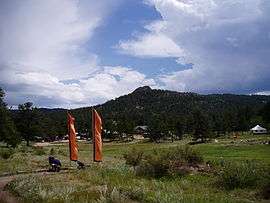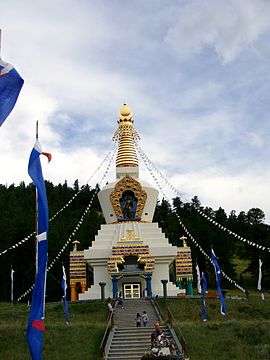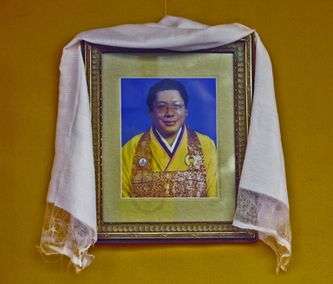Shambhala Mountain Center
The Shambhala Mountain Center was founded by Vidyadhara Chögyam Trungpa Rinpoche in 1971 at Red Feather Lakes, Colorado (40°44′N 105°32.5′W). Trungpa arrived in Boulder, Colorado, in 1970 with a number of students from Tail of the Tiger in Barnet, Vermont, now known as Karmê Chöling. Immediately students appeared from the neighboring towns and came from all parts of the country to become part of the Karma Dzong Meditation Center in Boulder. Among these were the members of a commune called the Pigmy Farm, located on the eastern edge of the city. In early 1971 a student of Trungpa Rinpoche, Jonathan Eric, inherited $100,000 from an uncle. He gave the money to Trungpa and Karma Dzong, and it was used to purchase what became the Rocky Mountain Dharma Center (now called Shambhala Mountain Center), as well as Tail of the Tiger in Barnet, Vermont (now called Karme Chöling). The Pigmies and others were the original inhabitants.

The property is nestled on 600 acres (2.4 km²) of grassy fields, forest, ponds, and streams. The center boasts 35,000 square feet (3,300 m2) of building space for meditation, dharma talks, programs, and lodging.
The center hosts regular Shambhala Training programs as well as yoga instruction, leadership training, children's programs, and various longer term retreats.

Following the death of Trungpa in 1987, his followers began a fourteen-year process of building a stupa at the Shambhala Mountain Center. Consecrated in August 2001, The Great Stupa of Dharmakaya reaches 108 feet (33 m) and is open to visitors daily.[1] Trungpa's relics are permanently entombed in the Stupa following Tibetan Buddhist tradition.
Shambhala Mountain Center is affiliated with Shambhala International.
Shambhala Mountain Center was previously known as Rocky Mountain Dharma Center (RMDC) and Rocky Mountain Shambhala Center.
References
- It is noted on the Stupa and is common knowledge among Shambhala practitioners who have visited SMC that Trungpa's relics are entombed in the Stupa following Tibetan Buddhist tradition.
External links
 Chogyam Trungpa Rinpoche
Chogyam Trungpa Rinpoche